Plans are afoot to reuse spent
reactor fuel in the U.S. But the advantages of the scheme pale in comparison
with its dangers
Although a dozen years have elapsed since
any new nuclear power reactor has come online in the U.S., there are now
stirrings of a nuclear renaissance. The incentives are certainly in place:
the costs of natural gas and oil have skyrocketed; the public increasingly
objects to the greenhouse gas emissions from burning fossil fuels; and
the federal government has offered up to $8 billion in subsidies and insurance
against delays in licensing (with new laws to streamline the process) and
$18.5 billion in loan guarantees. What more could the moribund nuclear
power industry possibly want?
Just one thing: a place to ship its used reactor
fuel. Indeed, the lack of a disposal site remains a dark cloud hanging
over the entire enterprise. The projected opening of a federal waste storage
repository in Yucca Mountain in Nevada (now anticipated for 2017 at the
earliest) has already slipped by two decades, and the cooling pools holding
spent fuel at the nation’s nuclear power plants are running out of space.
Most nuclear utilities are therefore beginning
to store older spent fuel on dry ground in huge casks, each typically containing
10 tons of waste.
Every year a 1,000-megawatt reactor discharges
enough fuel to fill two of these casks, each costing about $1 million.
But that is not all the industry is doing. U.S. nuclear utilities are suing
the federal government, because they would not have incurred such expenses
had the U.S. Department of Energy opened the Yucca Mountain repository
in 1998 as originally planned. As a result, the government is paying for
the casks and associated infrastructure and operations—a bill that is running
about $300 million a year.
Under pressure to start moving the fuel off
the sites, the DOE has returned to an idea that it abandoned in the 1970s—to
“reprocess” the spent fuel chemically, separating the different elements
so that some can be reused. Vast reprocessing plants have been running
in France and the U.K. for more than a decade, and Japan began to operate
its own $20-billion facility in 2006. So this strategy is not without precedent.
But, as I discuss below, reprocessing is an expensive and dangerous road
to take.
The Element from Hell
Grasping my reasons for rejecting nuclear
fuel reprocessing requires nothing more than a rudimentary understanding
of the nuclear fuel cycle and a dollop of common sense. Power reactors
generate heat—which makes steam to turn electricity-generating turbines—by
maintaining a nuclear chain reaction that splits (or “fissions”) atoms.
Most of the time the fuel is uranium, artificially enriched so that 4 to
5 percent is the chain-reacting isotope uranium 235; virtually all the
rest is uranium 238. At an enrichment of only 5 percent, stolen reactor
fuel cannot be used to construct an illicit atom bomb.
In the reactor, some of the uranium 238 absorbs
a neutron and becomes plutonium 239, which is also chain-reacting and can
in principle be partially “burned” if it is extracted and properly prepared.
This approach has various drawbacks, however. One is that extraction and
processing cost much more than the new fuel is worth. Another is that recycling
the plutonium reduces the waste problem only minimally. Most important,
the separated plutonium can readily serve to make nuclear bombs if it gets
into the wrong hands; as a result, much effort has to be expended to keep
it secure until it is once more a part of spent fuel.
These drawbacks become strikingly clear when
one examines the experiences of the nations that have embarked on reprocessing
programs. In France, the world leader in reprocessing technology, the separated
plutonium (chemically combined with oxygen to form plutonium dioxide) is
mixed with uranium 238 (also as an oxide) to make a “mixed oxide,” or MOX,
fuel. After being used to generate more power, the spent MOX fuel still
contains about 70 percent as much plutonium as when it was manufactured;
however, the addition of highly radioactive fission products created inside
a reactor makes this plutonium difficult to access and make into a bomb.
The used MOX fuel is shipped back to the reprocessing facility for indefinite
storage. Thus, France is, in effect, using reprocessing to move its problem
with spent fuel from the reactor sites to the reprocessing plant.
Japan is following France’s example. The U.K.
and Russia simply store their separated civilian plutonium—about 120 tons
between them as of the end of 2005, enough to make 15,000 atom bombs.
Until recently, France, Russia and the U.K.
earned money by reprocessing the spent fuel of other nations, such as Japan
and Germany, where domestic antinuclear activists demanded that the government
either show it had a solution for dealing with spent fuel or shut down
its reactors. Authorities in these nations found that sending their spent
fuel abroad for reprocessing was a convenient, if costly, way to deal with
their nuclear wastes—at least temporarily.
With such contracts in hand, France and the
U.K. were easily able to finance new plants for carrying out reprocessing.
Those agreements specified, however, that the separated plutonium and any
highly radioactive waste would later go back to the country of origin.
Russia has recently adopted a similar policy. Hence, governments that send
spent fuel abroad need eventually to arrange storage sites for the returning
radioactive waste. That reality took a while to sink in, but it has now
convinced almost all nations that bought foreign reprocessing services
that they might as well store their spent fuel and save the reprocessing
fee of about $1 million per ton (10 times the cost of dry storage casks).
So France, Russia and the U.K. have lost virtually
all their foreign customers. One result is that the U.K. plans to shut
down its reprocessing plants within the next few years, a move that comes
with a $92-billion price tag for cleaning up the site of these facilities.
In 2000 France considered the option of ending reprocessing in 2010 and
concluded that doing so would reduce the cost of nuclear electricity. Making
such a change, though, might also engender acrimonious debates about nuclear
waste—the last thing the French nuclear establishment wants in a country
that has seen relatively little antinuclear activism.
Japan is even more politically locked into
reprocessing: its nuclear utilities, unlike those of the U.S., have been
unable to obtain permission to expand their on-site storage. Russia today
has just a single reprocessing plant, with the ability to handle the spent
fuel from only 15 percent of that country’s nuclear reactors. The Soviets
had intended to expand their reprocessing capabilities but abandoned those
plans when their economy collapsed in the 1980s.
During the cold war, the U.S. operated reprocessing
plants in Washington State and South Carolina to recover plutonium for
nuclear weapons. More than half of the approximately 100 tons of plutonium
that was separated in those efforts has been declared to be in excess of
our national needs, and the DOE currently projects that disposing of it
will cost more than $15 billion. The people who were working at the sites
where this reprocessing took place are now primarily occupied with cleaning
up the resulting mess, which is expected to cost around $100 billion.
In addition to those military operations,
a small commercial reprocessing facility operated in upstate New York from
1966 to 1972. It separated 1.5 tons of plutonium before going bankrupt
and becoming a joint federal-state cleanup venture, one projected to require
about $5 billion of taxpayers’ money.
With all the problems reprocessing entailed,
one might rightly ask why it was pursued at all. Part of the answer is
that for years after civilian nuclear power plants were first introduced,
the U.S. Atomic Energy Commission (AEC) promoted reprocessing both domestically
and abroad as essential to the future of nuclear power, because the industry
was worried about running out of uranium (a concern that has since abated).
But that was before the security risks of
plutonium production went from theoretical to real. In 1974 India, one
of the countries that the U.S. assisted in acquiring reprocessing capabilities,
used its first separated plutonium to build a nuclear weapon. At about
this time, the late Theodore B. Taylor, a former U.S. nuclear weapons designer,
was raising an alarm about the possibility that the planned separation
and recycling of thousands of tons of plutonium every year would allow
terrorists to steal enough of this material to make one or more nuclear
bombs.
Separated plutonium, being only weakly radioactive,
is easily carried off—whereas the plutonium in spent fuel is mixed with
fission products that emit lethal gamma rays. Because of its great radioactivity,
spent fuel can be transported only inside casks weighing tens of tons,
and its plutonium can only be recovered with great difficulty, typically
behind thick shielding using sophisticated, remotely operated equipment.
So unseparated plutonium in spent fuel poses a far smaller risk of ending
up in the wrong hands.
Having been awakened by India to the danger
of nuclear weapons proliferation through reprocessing, the Ford administration
(and later the Carter administration) reexamined the AEC’s position and
concluded that reprocessing was both unnecessary and uneconomic. The U.S.
government therefore abandoned its plans to reprocess the spent fuel from
civilian reactors and urged France and Germany to cancel contracts under
which they were exporting reprocessing technology to Pakistan, South Korea
and Brazil.
The Reagan administration later reversed the
Ford-Carter position on domestic reprocessing, but the U.S. nuclear industry
was no longer interested. It, too, had concluded that reprocessing to make
use of the recovered plutonium would not be economically competitive with
the existing “once-through” fueling system. Reprocessing, at least in the
U.S., had reached a dead end, or so it seemed.
|
suite:
Rising from Nuclear Ashes
The current Bush administration has recently
breathed life back into the idea of reprocessing spent nuclear fuel as
part of its proposal to deploy a new generation of nuclear reactors. According
to this vision, transuranics (plutonium and other similarly heavy elements
extracted from conventional reactor fuel) would be recycled not once but
repeatedly in the new reactors to break them down through fission into
lighter elements, most of which have shorter half-lives. Consequently,
the amount of nuclear waste needing to be safely stored for many millennia
would be reduced [see “Smarter Use of Nuclear Waste,” by William H. Hannum,
Gerald E. Marsh and George S. Stanford; Scientific American, December 2005].
Some scientists view this new scheme as “technically sweet,” to borrow
a phrase J. Robert Oppenheimer once used to describe the design for
the hydrogen bomb. But is it really so wise?
The proposal to recycle U.S. spent fuel in
this way is not new. Indeed, in the mid-1990s the DOE asked the U.S. National
Academy of Sciences (NAS) to carry out a study of this approach to reducing
the amount of long-lived radioactive waste. The resulting massive report,
Nuclear Wastes: Technologies for Separation and Transmutation, was very
negative. The NAS panel concluded that recycling the transuranics in the
first 62,000 tons of spent fuel (the amount that otherwise would have been
stored in Yucca Mountain) would require “no less than $50 billion and easily
could be over $100 billion”—in other words, it could well cost something
like $500 for every person in the U.S. These numbers would have to be doubled
to deal with the entire amount of spent fuel that existing U.S. reactors
are expected to discharge during their lifetimes.
Why so expensive? Because conventional reactors
could not be employed. Those use water both for cooling and for slowing
down the neutrons given off when the uranium nuclei in the fuel break apart;
this slowing allows the neutrons to induce other uranium 235 atoms to split,
thereby sustaining a nuclear chain reaction. Feeding recycled fuel into
such a reactor causes the heavier transuranics (plutonium 242, americium
and curium) to accumulate. The proposed solution is a completely different
type of nuclear reactor, one in which the neutrons get slowed less and
are therefore able to break down these hard-to-crack atoms.
During the 1960s and 1970s the leading industrial
countries, including the U.S., put the equivalent of more than 50 billion
of today’s dollars into efforts to commercialize such fast-neutron
reactors, which are cooled by molten sodium rather than water. These devices
were also called breeder reactors, because they were designed to generate
more plutonium than they consumed and therefore could be much more efficient
in using the energy in uranium. The expectation was that breeders would
quickly replace conventional water-cooled reactors. But sodium-cooled reactors
proved to be much more costly to build and troublesome to operate than
expected, and most countries abandoned their efforts to commercialize them.
It is exactly this failed reactor type that
the DOE now proposes to develop and deploy—but with its core reconfigured
to be a net plutonium burner rather than a breeder. The U.S. would have
to build between 40 and 75 1,000-megawatt reactors of this type to be able
to break down transuranics at the rate they are being generated in the
nation’s 104 conventional reactors. If each of the new sodium-cooled reactors
cost $1 billion to $2 billion more than one of its water-cooled cousins
of the same capacity, the federal subsidy necessary would be anywhere from
$40 billion to $150 billion, in addition to the $100 billion to $200 billion
required for building and operating the recycling infrastructure. Given
the U.S. budget deficit, it seems unlikely that such a program would actually
be carried through.
If a full-scale reprocessing plant were constructed
(as the DOE until recently was proposing to do by 2020) but the sodium-cooled
reactors did not get built, virtually all the separated transuranics would
simply go into indefinite storage. This awkward situation is exactly what
befell the U.K., where the reprocessing program, started in the 1960s,
has produced about 80 tons of separated plutonium, a legacy that will cost
tens of billions of dollars to dispose of safely.
Reprocessing spent fuel and then storing the
separated plutonium and radioactive waste indefinitely at the reprocessing
plant is not a disposal strategy. Rather it is a strategy for disaster,
because it makes the separated plutonium much more vulnerable to theft.
In a 1998 report the U.K.’s Royal Society (the equivalent of the NAS),
commenting on the growing stockpile of civilian plutonium in that country,
warned that “the chance that the stocks of plutonium might, at some stage,
be accessed for illicit weapons production is of extreme concern.” In 2007
a second Royal Society report reiterated that “the status quo of continuing
to stockpile a very dangerous material is not an acceptable long-term option.”
Clearly, prudence demands that plutonium should
not be stored at a reprocessing facility in a form that could readily be
stolen. Indeed, common sense dictates that it should not be separated at
all. Until a long-term repository is available, spent reactor fuel can
remain at the sites of the nuclear power plants that generated it.
Would such storage be dangerous? I would argue
that keeping older fuel produced by the once-through system in dry storage
casks represents a negligible addition to the existing nuclear hazard to
the surrounding population. The 10 kilowatts of radioactive heat generated
by the 10 tons of 20-year-old fuel packed in a dry storage cask is carried
off convectively as it warms the air around it. Terrorists intent on doing
harm might attempt to puncture such a cask using, say, an antitank weapon
or the engine of a crashing aircraft, but under most circumstances only
a small mass of radioactive fuel fragments would be scattered about a limited
area. In contrast, if the coolant in the nearby reactor were cut off, its
fuel would overheat and begin releasing huge quantities of vaporized fission
products within minutes. And if the water were lost in a storage pool containing
spent fuel, the zirconium cladding of the fuel rods would be heated up
to ignition temperature within hours. Seen in this light, dry storage casks
look pretty benign.
Is there enough physical room to keep them?
Yes, there is plenty of space for more casks at U.S. nuclear power plants.
Even the oldest operating U.S. reactors are having their licenses extended
for another 20 years, and new reactors will likely be built on the same
sites. So there is no reason to think that these storage areas are about
to disappear. Eventually, of course, it will be necessary to remove the
spent fuel and put it elsewhere, but there is no need to panic and adopt
a policy of reprocessing, which would only make the situation much more
dangerous and costly than it is today.
Fear and Loathing in Nevada
The long-term fate of radioactive waste in
the U.S. hinges on how the current impasse over Yucca Mountain is resolved.
Opinion on the site is divided. The regulatory requirements are tough:
the DOE has to show that the mountain will contain the waste well enough
to prevent significant off-site doses for a million years.
Demonstrating safety that far into the future
is not easy, but the risks from even a badly designed repository are negligible
in comparison with those from a policy that would make nuclear weapons
materials more accessible. From this perspective, it is difficult to understand
why the danger of local radioactive pollution 100,000 or a million years
hence has generated so much more political passion in the U.S. than the
continuing imminent danger from nuclear weapons.
Part of the problem is the view in Nevada
that the Reagan administration and Congress acted unfairly in 1987 when
they cut short an objective evaluation of other candidate sites and designated
Yucca Mountain as the location for the future nuclear waste repository.
To overcome this perception, it may be necessary to reopen deliberations
for choosing an additional site. Such a move should not be difficult. Indeed,
the Nuclear Waste Policy Act of 1987 requires the secretary of energy to
report to Congress by 2010 on the need for a second storage facility. Given
the disastrous record of the DOE in dealing with radioactive waste, however,
consideration should also be given to establishing a more specialized and
less politicized agency for this purpose.
In the meantime, spent fuel can be safely
stored at the reactor sites in dry casks. And even after it is placed in
a geologic repository, it would remain retrievable for at least a century.
So in the unlikely event that technology or economic circumstances change
drastically enough that the benefits of reprocessing exceed the costs and
risks, that option would still be available. But it makes no sense now
to rush into an expensive and potentially catastrophic undertaking on the
basis of uncertain hopes that it might reduce the long-term environmental
burden from the nuclear power industry.
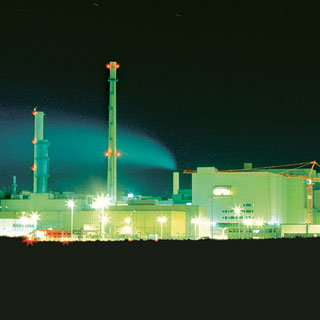
LA HAGUE, on France's Normandy coast, hosts a large complex that
reprocesses spent fuel from nuclear power plants, extracting its plutonium
for fabrication into new fuel. The U.S. Department of Energy has recently
proposed building a similar facility.
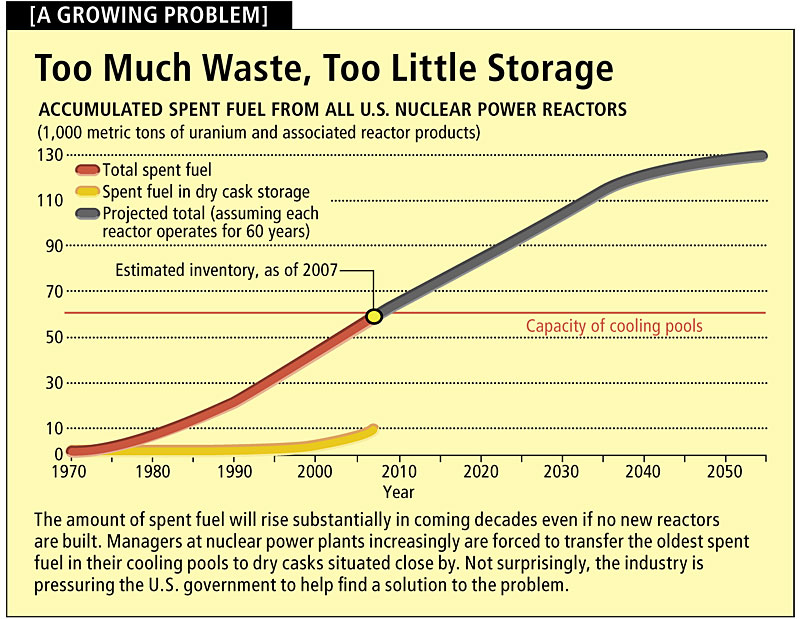 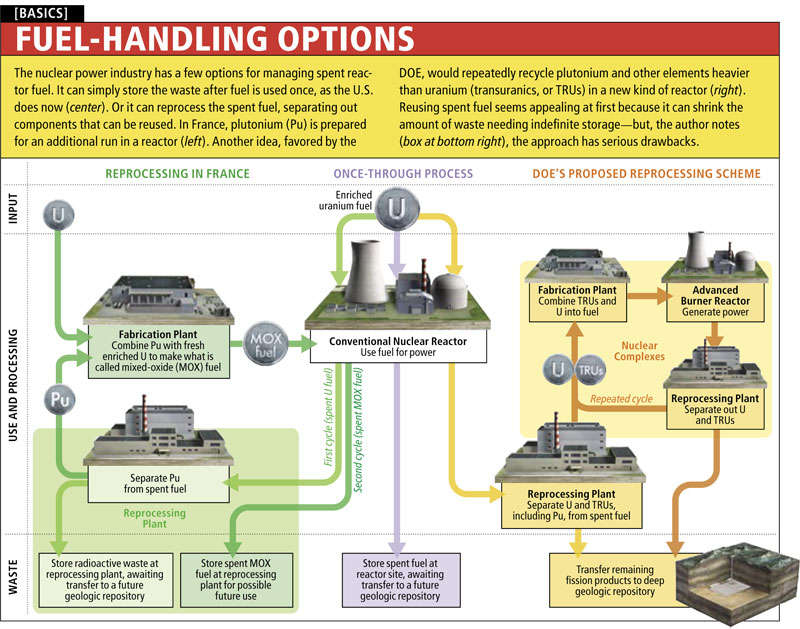
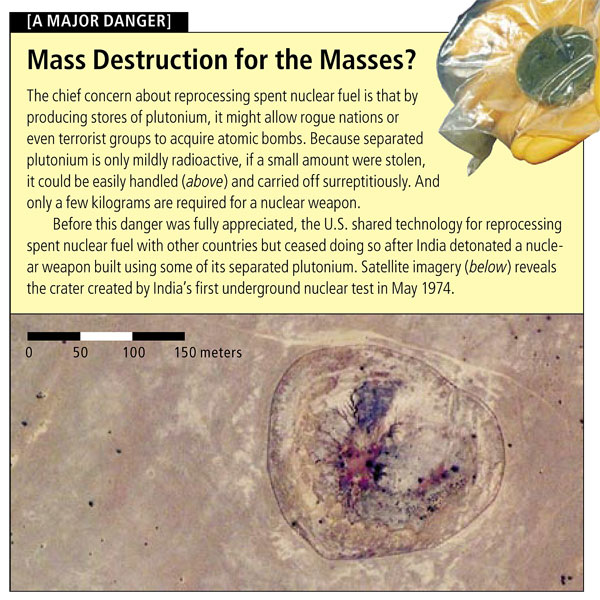 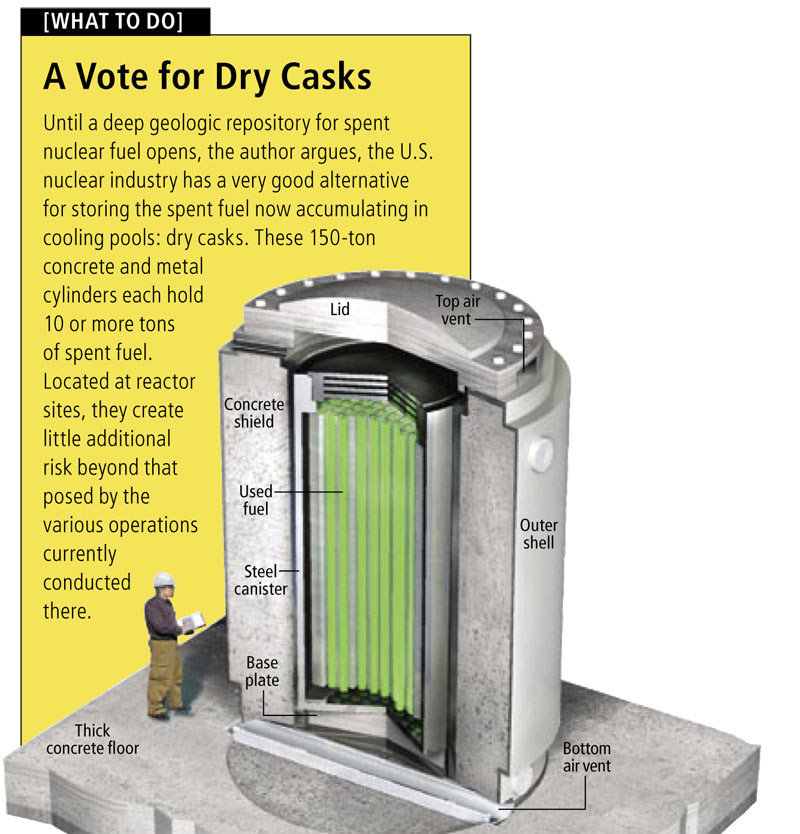
|




